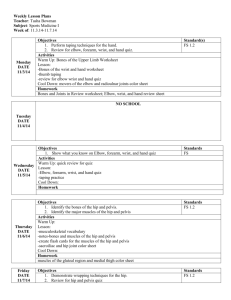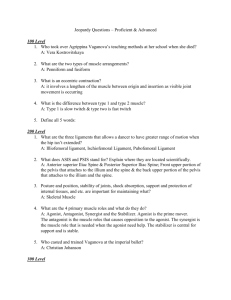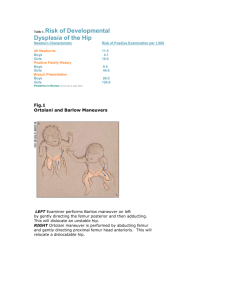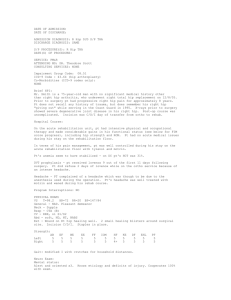Pelvic Girdle & Hip Joint
advertisement
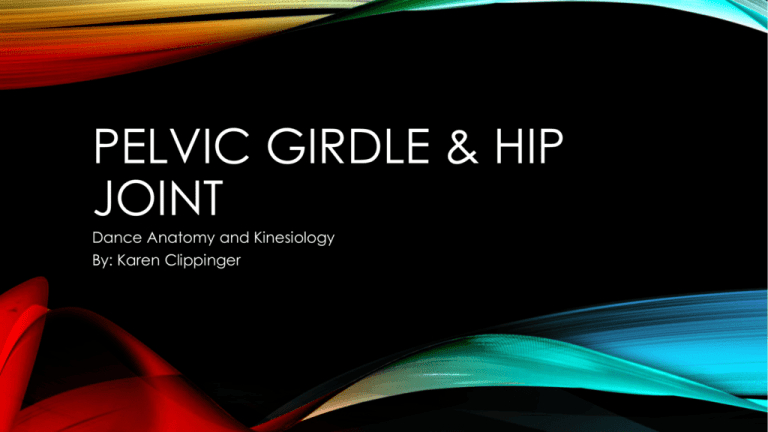
PELVIC GIRDLE & HIP JOINT Dance Anatomy and Kinesiology By: Karen Clippinger THE SPINE The spine has four main sections: The Cervical Spine – 7 Vertebrae The Thoracic Spine – 12 Vertebrae The Lumbar Spine – 5 Vertebrae The Sacrum – 3-5 Fused (and the Coccyx) Vocabulary of the body to remember! Superior Above Inferior Below Anterior Forward of Posterior Behind Medial Inside Lateral Outside BONES & BONY LANDMARKS • The sides of the pelvis are termed the OS COXAE • Each side is made up of 3 bones: • Ilium (Groin), Ischium (Hip), Pubis (Genitals) • They are fused and become a single bone at 15 or 16 years old • ILIUM is a flat bone that is the largest of the three, forms the large upper side portion of the pelvis • Smooth concaved part of ilium is the ILIAC FOSSA, the superior convex border of the ilium is the ILIAC CREST. • Bony prominences forward of the Iliac crests are the ANTERIOR SUPERIOR ILIAC SPINE (ASIS) and the bony prominences backward of the iliac crest are the POSTERIOR SUPERIOR ILIAC SPINE (PSIS) • KEY: for evaluating pelvis symmetry and alignment BONES & BONY LANDMARKS • ISCHIUM is an irregular bone that is the strongest of the three, located at the lower posterior portion of the pelvis • Most inferior portion of this bone has rough eminences, upon which we sit, ISCHIAL TUBEROSITIES • Key: This landmark is key for teaching turnout and pelvic alignment • Thin flatten portion of Ischium is the RAMUS which ascends upward and forward to join with the INFERIOR RAMUS of the pubis • Pubis is an irregular bone located in the anterior and inferior portion of the pelvis • The thin and flatten SUPERIOR RAMUS ascends and joins with the ilium • Together the RAMI and other parts of pelvis form a large opening called the OBTURATOR FORAMEN • Largest foramen in the body • Attachment point for muscles and ligament key for effecting turnout BONES AND BONY LANDMARKS Each Os Coxae contains a cavity called acetabulum which is where the head of the femur (leg) attaches BONES AND BONY LANDMARKS This is one area of the skeleton were there are gender like differences JOINT STRUCTURE & MOVEMENTS OF PELVIC GIRDLE • The Os Coxae are joined firmly to the sacrum posteriorly and to the sacroiliac joints AND anteriorly to each other at the PUBIC SYMPHYSIS forming one solid structure…The PELVIC GIRDLE • The pelvic girdle provides connection between the lower limbs and the axial skeleton • Also supports and protects vital lower abdominal organs • Public Symphysis (growing together), is a cartilaginous joint and allows slight movement for shock absorbency. During pregnancy ligaments become lax to allow more movement associated with pregnancy JOINT STRUCTURE & MOVEMENTS OF PELVIC GIRDLE • Sacroiliac Joints (sacred), are the joints between the sacrum of the spine and the right and left ilium. • • • • They are quite stable due to the presence of many ligament attachments Sacrum sits like a wedge between the ilia Connection here adds stability and limits movement in certain directions Common injury site in dancers • Movements of the Pelvic Girdle • The limited movement of the pubic symphysis and sacroiliac joints allows the pelvic girdle to essentially function as a single unit • Good for stability and protection and support pelvis functions • Limiting in terms of movement and therefore the lower spine, the lumbosacral joint become important for facilitating positional changes in the pelvis • Anterior Tilt, Posterior Tilt, Lateral Tilt and Rotation JOINT STRUCTURE & MOVEMENT OF THE HIP • In upright posture like walking or running, the weight of the body is transmitted down through the spine and pelvis through one or both rotary hip joints. In addition to withstanding these downward forces of gravity, the hip joint also transmits forces from the ground to the pelvis. • These important force transmission functions make joint stability and strength a priority. However, sufficient mobility must be present to facilitate locomotor movement. • The joint architecture, with its unique arrangements to muscles and ligaments helps meet the bias of stability while allowing adequate mobility. JOINT STRUCTURE & MOVEMENT OF THE HIP • Hip Joint Classification and Associated Movements • The hip joint, the actebularfemoral joint, is a balland-socket joint which is formed between the acetabulum and the head of the femur • Due to the depth of the socket and broad surface areas of contact between the articulating bones, joint stability is favored • Approx 70% of the femur articulates with the acetabulum • In contrast only 25% of the head of the humerus (arm) contacts with the shoulder socket • Classic ball-and-socket joints have 3 degrees of freedom of motion • Flexion-Extension • Abduction-Adduction • External-Internal Rotation • Photos: Page 162 JOINT STRUCTURE & MOVEMENT OF THE HIP • Hip Joint Capsule and Key Ligaments • A strong, dense capsule, encloses the entire hip joint. It attaches from the actebulum and runs distally (away from the hip) to the neck of the femur, encasing it like a tube. The capsule has thickened ligamental bands that spiral around the neck of the femur named: Iliofemoral, pubofemoral and ischiofemoral ligaments. • Due to their tight spiral arrangement, they become important for providing stability in upright standing • Photos: Page 163 JOINT STRUCTURE & MOVEMENT OF THE HIP • ILIOFEMORAL LIGAMENT is located at the front of the hip joint, spiraling inferiorly from the anterior inferior iliac spine of the pelvis to diverge into two bands that attach to the upper and lower portions of the intertrochanteric line. • • • • • Sometimes called the “Y” ligament, because of it appearance One of the strongest ligaments in the body Plays a very important role while standing Gravity generally passes behind center of rotation and extends the hip joint Iliofemoral joint become taut w/hip extension and allows standing to be maintained • Prevents the trunk from falling backward or the head of the femur from displacing anteriorly • Serves as powerful constraint in bring leg behind you, like tendu or arabesque • Limits hyperextension to 10 or 20 degrees but dancers have increased this to 40 degrees • Due to the restraint some dancers adopt the undesired tactic of anteriorly tilting the pelvis when trying to achieve greater turnout • PUBOFEMORAL LIGAMENT is located on the anterior and lower portion of the capsule and runs between the pubic bone and an area near the less trochanter • Assists iliofemoral ligament in limiting hip extension and external rotation. • ISCHIOFEMORAL LIGAMENT is located at the posterior part of the hip and provides protection from posterior displacement of the femur. It spans between the ischium and just below the acetabulum • Prevents hip internal rotation and horizontal adduction JOINT STRUCTURE & MOVEMENT OF THE HIP • Specialized Structures of the Hip • Various structures provide joint stability and aid in joint function • Acetabular Labrum (lip shaped structure), is a specialized rim of fibrocartilage that is considerably thicker at the circumference, thus increasing the depth of the acetabulum and helping hold the head of the demur in place. • This thickness also provides cushioning for the top and back of the acetabulum against large compression forces of the head of the femur. • This Labrum improves joint stability and protects the bone • Suction: There is a difference of atmospheric pressure in the hip joint, similar to a vacuum that pulls the head of the femur into the socket • The depth of the acetabulum, the presence of the acetabular labrum and suction keep the joint in tack • Even if all the muscles and ligaments were cut, the joint will stay together (45lbs, 90lbs) • Bursae: (liquid sack) Two most common bursae that are inflamed in dancers are, 1 located over the greater trochanter and 2 between the iliopsoas and the underlying articular capsule • Muscles: In addition, many strong muscles cross the hip joint and provide stabilization. These muscles are much larger and stronger than those in the upper extremity PELVIS VOCABULARY • Os Coxae • Obturator Foramen • Ilium • Pubic Symphysis • Iliac Fossa • Iliofemoral Ligament • Iliac Crest • Pubofemoral Ligament • Anterior Superior Iliac Spine • Ischialfemoral Ligament • Posterior Superior Iliac Spine • Acetabular Labrum • Ischium • Suction • Ischial Tuberosity • Bursae FUNCTIONS OF INDIVIDUAL HIP MUSCLES • 22 Muscles Cross the Hip Joint • • • • The Anterior muscles are hip flexors The Posterior muscles are hip extensors (except the deep rotator muscles) The Lateral group are hip abductors The Medial group are hip adductors • Although the primary action is the same their secondary action may differ • Keep in mind the hip has 3 degrees of motion and many muscles will use all three simultaneously, however 1 or 2 often dominate • Also, the action of a muscle may differ with changes in the joint angle due to the shift in the line of pull relative to the axis ALIGNMENT & COMMON DEVIATIONS OF THE HIP REGION • Alignment of the bones in the hip region influence the bones above and below the pelvis and hip joint. • For Example, the alignment of the pelvis will influence the spine above and the knee, ankle and foot below • Three Alignment Considerations are particularly important • Pelvic Inclinations/Pelvic Tilts • The angle of femoral inclination • The angle of femoral torsion • Position of the Pelvis is NEUTRAL -> Deviations • Anterior & Posterior Tilts • Right & Left Lateral Tilts • Right & Left Rotations • To identify pelvic alignment these bony landmarks are used: • Iliac Crest, ASIS, PSIS, Pubic Symphysis INDIVIDUAL MUSCLES OF THE HIP • Anterior pg. 165, 166 • These muscles cross anterior to the axis of the hip joint for flexion-extension • Common action used in walking, running, leaping • Illiopsoas, Rectus Femoris, Sartorius • Posterior pg. 167-169 • Gluteus Maximus, Iliotibal band, Hamstrings, Deep Outward Rotators • Lateral pg. 171 • Gluteus Medius & Minimus, Tensor Fasciae Latae • Medial pg. 172, 173 • Adductor Longus, Adductor Brevis, Adductor Magnus, Pectineus, Gracilis • View pages for photos INDIVIDUAL MUSCLES OF THE HIP ANTERIOR MUSCLES • • • • • • • • • • ILIOPSOAS – Psoas Major and Iliacus They share a common distal attachment Appear to act together in movement, hence, iliopsoas 16 inches long Runs deep under the abs from the front of the lower spine and inner portion of the illium downward to attach onto the medial side of the upper femur at the lesser trochanter Hard to feel because of how deep it sits One of the most powerful muscles in the body, can develop to pull 1000lbs Most important muscle in hip flexion above 90 degrees Assists with hip abduction at higher ranges (high developpes front or side) Only muscles in the human body that attaches to the spine, pelvis and femur • Due to this: Iliopsoas stabilizes the hip and effects position of lumbar spine • Prevents the torso from falling backward, maintains lumbar curve INDIVIDUAL MUSCLES OF THE HIP • RECTUS FEMORIS – 1 of the 4 Muscles that make up your quadriceps femoris • Only member of the group that crosses the hip joint • Rectus means straight, therefore rectus femoris runs straight down the front of the femur • Flexes the hip and extends the knee • This combination of hip flexion and knee extension gave name “kicking muscle” • • • • • • SARTORIUS – The longest muscle in the body Slender, runs from front of pelvis down thigh to attach medially to the tibia Assists Hip flexion and also abducts and can externally rotate the hip Commonly called “tailor’s muscle” – Sartor = a tailor Combination of motions in dance would be passe’ Due to long, thin composition, it is designed for speed rather than strength • Making it a common injury site for dancers • Can also produce flexion or internal rotation of the knee INDIVIDUAL MUSCLES OF THE HIP POSTERIOR MUSCLES • GLUTEUS MAXIMUS – Largest, most superficial of the buttocks muscles • Forms the roundness of the back of the buttocks • Large size in humans thought to be due to demands of upright stance • Most powerful hip extensor • Which is crucial for movements like walking up stairs, hills, running, jumping • In addition to hip extension, also can produce hip external rotation • Due to insertion to the ilotibial band (a strong fascia of the lateral thigh that spans between the pelvis and lower leg) the gluteus maximus indirectly helps support the femur upon the tibia • HAMSTRINGS – form the bulk of the back of the thigh • Composed of 3 muscles: Biceps femoris, semitendinosus, deeper semimembranosus INDIVIDUAL MUSCLES OF THE HIP POSTERIOR MUSCLES • HAMSTRINGS – (Continued) • Their action of extension comes into play with everyday movements • Standing, walking, controlling forward motion of the torso • Function is considered more postural and fine-tuning • Whereas the Gluteus is more power • All 3 muscles attach distal to the knee & act as knee flexors and hip extensors • BICEPS FEMORIS (lateral) – particularly active in hip extension considered to be “workhorse” for hip extension • Insert laterally to tibia and fibula • Assist with knee external rotation or hip external rotation when the hip and knee are extended • SEMITENDENOSUS & SEMIMEMBRANOSUS (medial) insert into medial part of the tibia • Assist with knee internal rotation or hip internal rotation when the hip and knee are extended INDIVIDUAL MUSCLES OF THE HIP POSTERIOR MUSCLES • DEEP OUTWARD ROTATOR MUSCLE GROUP • Piriformis, Quadratus Femoris, Obturator Internus, Obturator Externus, Gemellus Superior, Gemellus Inferior • • • • • These 6 muscles are deep into the gluteus Fiber run horizontally, spanning from inside to outside PIRIFORMIS, most superior of the group is located slightly above hip joint QUADRATUS FEMORIS, most inferior is located slightly below the hip joint OBTURATOR INTERNUS & GEMELLI are located between the two • Obturator Internus has extensive attachments to internal surface membrane covering the obturator foramen and surrounding areas • Obturator Externus has extensive attachments to external obturator surface membrane and adjacent bones • Gemellus Superior accompanies above • Gemellus Inferior accompanies below • Together referred to as Three-Headed Muscle – Triceps Coxae INDIVIDUAL MUSCLES OF THE HIP POSTERIOR MUSCLES • DEEP OUTWARD ROTATOR MUSCLE GROUP • Function as a group • Help hold the head of the femur and the acetabulum • Help prevents upward jamming of the femur with hip abduction • Most known for action in hip external rotation • Ability of muscles group to produce hip external rotation without other motions makes this key for the production and maintenance of turnout • When at 90 degrees some muscles are in an effective position to produce hip horizontal abduction • Passe’ • Rond de jambe en l’air • Binder Order – Quarter 1 • Syllabus • Supply List • Ballerina* • Objectives - week of Sept 9 – Oct 21 • Muscle Packet • Ballet Vocabulary • Muscle Vocabulary 1-20 • Quiz 1 - Muscles • Muscle Vocabulary 21-40 • **Muscle notes or in class assignments • Progress Report • Test 1 - Muslces • Pelvis Packet • Pelvis Vocab • Quiz 2 – Pelvis • **Any make up work • **Items with double stars are not required to be in the binder


